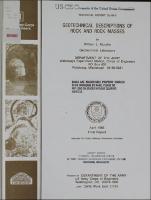Please use this identifier to cite or link to this item:
https://hdl.handle.net/11681/13106| Title: | Geotechnical descriptions of rock and rock masses |
| Authors: | Murphy, William L. (William Lee), 1944- |
| Keywords: | Rocks Rock Rock core Rock masses Rock descriptors Rock classification |
| Publisher: | Geotechnical Laboratory (U.S.) Engineer Research and Development Center (U.S.) |
| Series/Report no.: | Technical report (U.S. Army Engineer Waterways Experiment Station) ; GL-85-3. |
| Description: | Technical Report Abstract: Geotechnical descriptors for rock and rock mass are suggested for use in the field that can be readily understood by geotechnical engineers and contractors. Several rock and rock mass properties and descriptors were determined to be important in geotechnical applications, including tunnel support, slope and foundation stability, and rock excavation. The descriptors are rock type, strength, discontinuity characterization, weathering, rock quality designation (RQD), ground-water conditions, and rock density. The rock name or type should be retained in field description, but uncommon rock names should be accompanied by a brief definition to enable the user to relate to more common rock types. Rock strength should be described quantitatively by the point load index test. Descriptions of discontinuities should include measurement and classification of aperture and a determination of whether the discontinuity is open or tight; filling thickness and composition; wall asperity or roughness; and orientation of individual discontinuities, sets and systems. The use of stereographic projection and unambiguous azimuthal notation to describe discontinuity orientation is recommended. Bieniawski's classification of rock weathering, which classifies degree of weathering and describes the appearance in the field, is recommended. The use of RQD in field descriptions as developed by Deere is suggested for certain applications. Field recognition and description of seepage and groundwater conditions along discontinuities based on simple observations of the amount of water present and estimates of discharge are recommended to precede and augment the design of more elaborate pore pressure and seepage analysis investigations. Wet density of rock samples can be determined in the field on core specimens by the standard Rock Testing Handbook Methods. |
| Rights: | Approved for public release; distribution is unlimited. |
| URI: | http://hdl.handle.net/11681/13106 |
| Appears in Collections: | Technical Report |
Files in This Item:
| File | Description | Size | Format | |
|---|---|---|---|---|
| TR-GL-85-3.pdf | 5.71 MB | Adobe PDF |  View/Open |